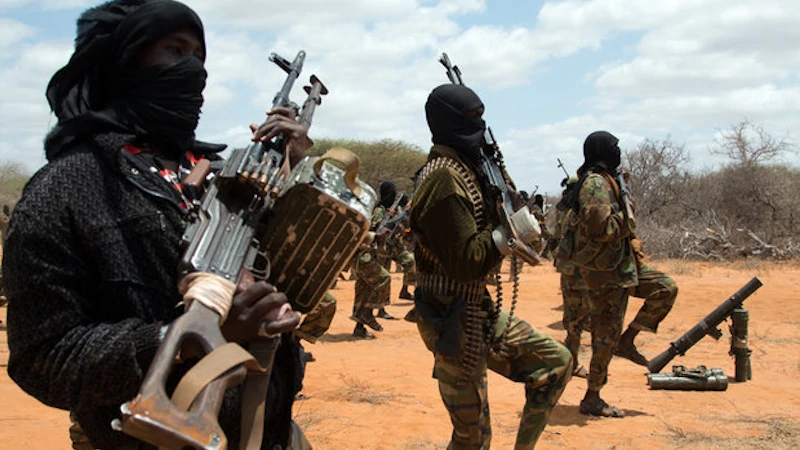Resilient Al-Shabaab Recruits East African Fighters As ATMIS Exits Somalia

Thick white smoke billowed over the rooftops and power lines at a military base housing Djiboutian troops attached to the African Union Transition Mission in Somalia (ATMIS).
Al-Shabaab claimed responsibility for the June 30 suicide bombing that killed at least four people — including a father, mother and their 7-year-old daughter — in the central Somali town of Beledweyne.
“We went to the place where the problem happened; it was really unimaginable that we collected the cut meat of our relatives,”Feylow Abdi Adan, the girl’s uncle, told the BBC.
Djiboutian forces were handing the base over to Somali troops amid ATMIS’ phased drawdown when the attack occurred. It was unclear whether any security forces were killed or injured.
The remaining ATMIS troops and support personnel are set to leave Somalia by the end of the year. However, al-Shabaab has grown more resilient after losing ground to Somali and international forces in 2022 and 2023.
“Striking the ATMIS base as it was being handed over to the Somali National Army (SNA) sends obvious signals about the strength Shabaab still maintains in central Somalia despite two years of constant military pressure in the area,” analyst Caleb Weiss wrote in the Foundation for Defense of Democracies’ Long War Journal. “Additionally, the strike demonstrates the fragility of the ATMIS drawdown.”
According to an AU assessment seen by The East African newspaper, al-Shabaab is increasingly adept at drone use and is creating new ways to use improvised explosive devices in its attacks. Analysts say the terror group has an adequate intelligence system and is now using open-source geographical data to plot assaults.
According to the AU, al-Shabaab has gradually formed a pan-East African force of foreign fighters known as Muhajirin. Most Muhajirins are Ethiopians, Kenyans and Tanzanians, although there are also Burundian, Congolese, Rwandan and Ugandan fighters.
The AU assessment reports that al-Shabaab also has established ties with the Allied Democratic Forces, a Ugandan group that also terrorizes the eastern Democratic Republic of the Congo.
Kenyan President William Ruto is among those who fear al-Shabaab could overwhelm security forces after ATMIS leaves. Kenya has nearly 3,500 troops in Somalia. Ruto told Somalia’s Garowe Online that he had concerns about the troop drawdown after speaking to Somali President Hassan Sheikh Mohamud.
“We have serious security challenges before [the] impending drawdown of ATMIS troops in Somalia that is calendar-based, not condition-based,” Ruto said. He called for the continued help of international troops. “Otherwise, the moment ATMIS exits, al-Shabaab will take over,” Ruto added.
Amid ongoing al-Shabaab assaults, the AU in late June backed the creation of a new AU-led, United Nations-funded (U.N.) force to replace ATMIS.
The AU Peace and Security Council (PSC) underscored the need for clear communication, command and control structures, and regular information sharing regarding the force, according to a report by Ethiopian newspaper The Reporter. It called for a framework that outlines the size, scope and mandate of the new mission.
The PSC also stressed the importance of predictable and sustainable funding for the mission. Amani Africa, a policy think tank based in Addis Ababa, Ethiopia, noted in an April report that ATMIS faced a “dire funding shortfall” as the transition continued.
ATMIS Head Ambassador Mohamed El-Amine Souef in late June described al-Shabaab’s unpredictable nature to the U.N. Security Council, citing recent attacks on Somali Security Forces (SSF) in El-Dheer, in the Galmudug region, and a mortar attack on an ATMIS camp in Baidoa, Southwest State.
“SSF supported by ATMIS, and increasingly local communities, achieved significant gains in the fight against al-Shabaab,” Souef said in a defenceWeb report. “Sustained support from international partners is essential to maintain this momentum.”
Security forces also have had recent success against al-Shabaab, capturing strategic villages in the group’s strongholds in Lower Juba and Middle Shabelle regions in June.
“While al-Shabaab lost the strategic villages without any confrontations, it is possible that this is a tactic used by the militants to draw the security forces close and subsequently launch an attack,” according to a report by the Armed Conflict Location & Event Data Project.
